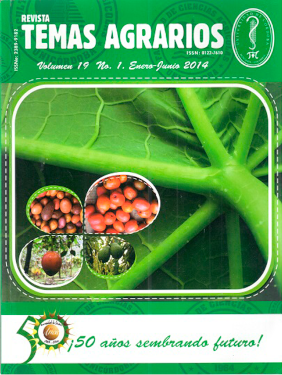Estudio de la capacidad de retención de boro disponible en suelos mediante membranas funcionales con cadenas de polioles
Study of available boron retention capacity in soils by functional membranes with polyol chains
Cómo citar
Vera, M., Combatt Caballero, E., & Palencia, M. (2016). Estudio de la capacidad de retención de boro disponible en suelos mediante membranas funcionales con cadenas de polioles. Temas Agrarios, 19(1), 96-105. https://doi.org/10.21897/rta.v19i1.728
Dimensions
Licencia

Esta obra está bajo una licencia internacional Creative Commons Atribución-NoComercial 4.0.
Mostrar biografía de los autores
Visitas del artículo 782 | Visitas PDF
Descargas
Los datos de descarga todavía no están disponibles.
- Agarwal, S., Greiner, A. and Wendorff, J. 2013. Functional materials by electrospinning of polymers. Progress in Polymer Science. 38: 963-991.
- Ahmad, W., Zia, M., Malhi, S. and Niaz, A. 2012. Boron Deficiency in soils and crops: a review. Crop Plant. p77-114.
- Aubert, H. and Pinta, M. 1977. Trace elements in soils. Elsevier Scientific, Amsterdam. 395p.
- Blevins, D. and Lukaszewski, K.1998. Boron in plant structure and function, Annual Reviews Plant Physiology Plant Molecular Biology. 49: 481-500.
- Bonilla, I. and Bolaños, L. 2009. Mineral Nutrition for Legume-Rhizobia Symbiosis: B,Ca, N, P, S, K, Fe, Mo, Co, and Ni: A Review, Journal Sustaintable Agricultural Environment. p253-274.
- Chaudhary, Y. and Shukla, L. 2004. Evaluation of extractantes for predicting availability of boron to mustard in arid soils of India. Communication in Soil Science Plant Analysis. 35: 267-283.
- Dembitsky, M. 2005. Contemporary aspects of boron: chemistry and biological applications. Elsevier B. V., Amsterdam. 593p.
- Handreck, K. 1990. Methods of assessing boron availability in potting media with special reference to toxicity. Communication in Soil Science Plant Analysis. 21: 2265-2280.
- Instituto Geografico Agustin Codazzi (IGAC). 2006. Métodos analíticos del laboratorio de suelos. VI Edición. Bogotá, Subdirección de Agrología.
- Lvov, Y. and Abdullayev, E. 2013. Functional polymer–clay nanotube composites with sustained release of chemical agentss. Progress in Polymer Science. 38: 1690-1719.
- McGreehan, S., Topper, K. and Naylor, D. 1989. Sources of variation in hot water extraction and colorimetric determination of soil boron, Communication Soil Science and Plant Analysis. 20: 1777-1786.
- Navarro, S. and Navarro, G. 2003. Química agrícola: El suelo y los elementos químicos esenciales para la vida vegetal. 2a ed. Mundi-prensa, Barcelona. 487 p.
- Palencia, M., Vera, M. and Combatt, M. 2014. Polymer networks based in (4-vinylbenzyl)-N-methyl-D-glucamine supported on microporous polypropylene layers with retention boron capacity. Journal of Applied Polymer Science, 131. DOI: 10.1002/app.40653
- Polat, H., Vengosh, A., Pankratov, I. and Polat, M. 2004. A new methodology for removal of boron from water by coal and fly ash, Desalination. 164: 173-188.
- Reid, R. 2010. Can we really increase yields by making crop plants tolerant to boron toxicity?. Plant Science. 178: 9-11.
- Rivas, B., Pereira, E., Palencia, M. and Sánchez, J. 2011. Water-soluble functional polymers in conjunction with membranes to remove pollutant ions from aqueous solutions, Progress in Polymer Science. 36: 294-322.
- Roig, A, López, F. and Hernández, F. 1996. Application of azomethine-H method to the determination of boron in workplace atmospheres from ceramic factories, Journal of Analytical Chemistry. 356: 103-106.
- Sah, R. and Brown, P. 1997. Boron determination - a review of analytical methods, Microchemical Journal. 56: 285-304. Ulbricht, U. 2006. Advanced functional polymer membranes, Polymer. 47: 2217- 262




















